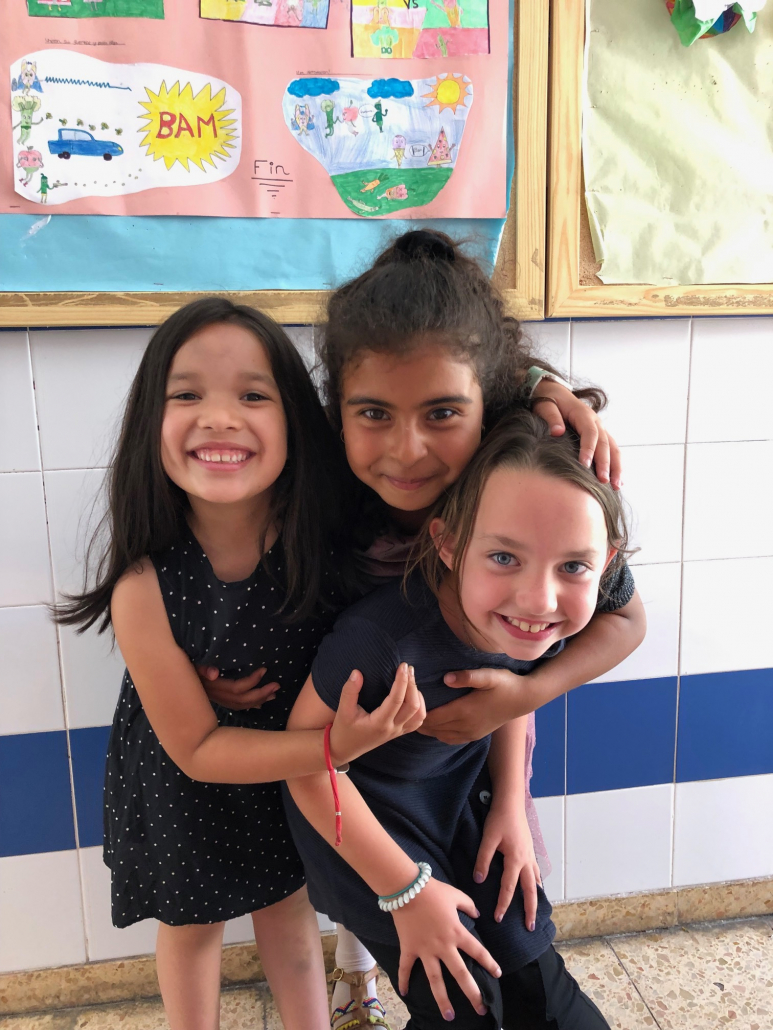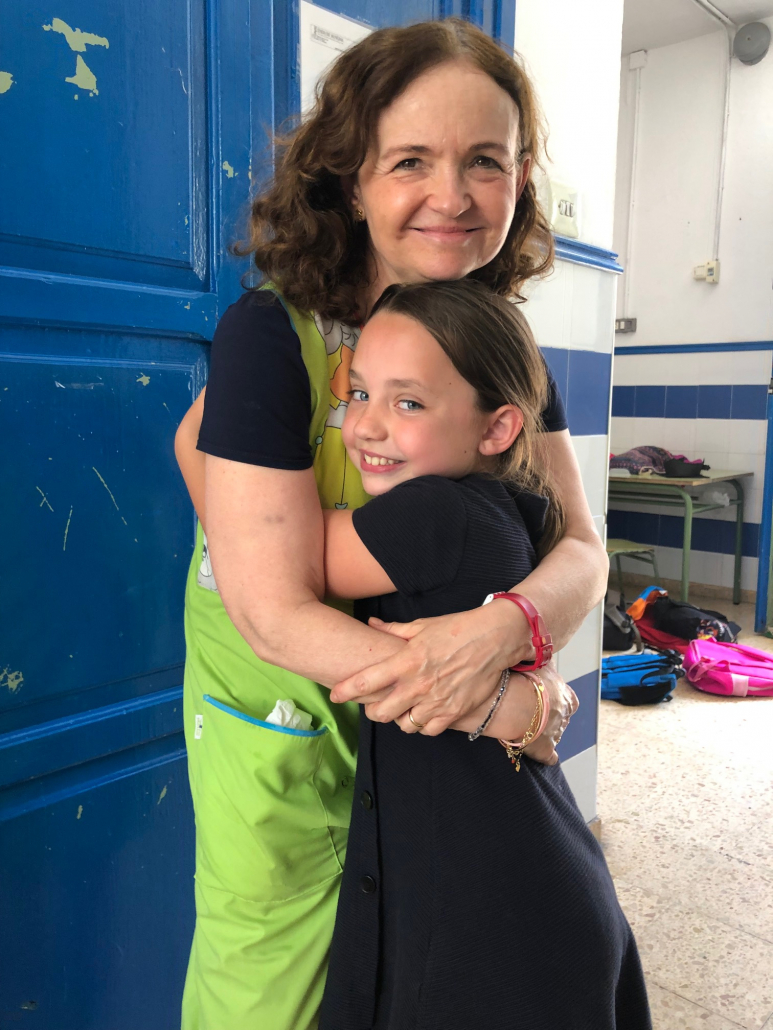Public Schools in Spain vs. the US
 For the sake of keeping this post factual, here is some interesting data. These figures are TOTALS from 2 different Spanish public schools for 2 children over the span of 1 and a half school years:
For the sake of keeping this post factual, here is some interesting data. These figures are TOTALS from 2 different Spanish public schools for 2 children over the span of 1 and a half school years:
- Emails received from teachers = 0
- Standardized tests = 0
- Fundraisers I’ve been asked to participate in = 0
- School sporting events = 0
- Newsletters sent home from school/teachers = 2
- Lunches packed = 2
- Dress up, concerts or spirit days requiring special purchases = 0
- School shootings in the history of Spain = 0
- Requested parent/teacher conferences = 5
I’ve broken the varying aspects of common public schools to draw comparisons. Friendly reminder that each school is different and this is my experience with 2 different schools in Valencia, Spain. Why are they in different schools? There was no space when we enrolled and the lack of openings continues to be problematic so if you are planning a move here, begin school searching asap. FYI my kids are 8 and 11 years old.
SMALLER/TIGHT KNIT CLASSES
Most classes sizes in Spain are between 18-25 students. The local law prohibits class sizes bigger than 25 in ages 3 – 12 classrooms.
Lots of Spanish families have lived in their homes and gone to the neighborhood school for generations. This means that classes are usually made up of students that have known each other since they were in diapers.
Also, elementary schools here start at age 3 to age 12 and there is only one class per grade level meaning each school has about 175 total kids.
LUNCH
No need to argue who does it best, the Spanish are leading by a landslide in both healthy meals and zero-waste cafeterias.
Most US public schools allow outside lunches, Spanish schools do not. Students either go home to eat for this 2 hour lunch/play break or they stay for lunch (comedor) and playground time.
In the Spanish cafeteria students are monitored in what they eat, how they eat, and how they clean up their eating area. There are no choices in the cafeteria – you are served what is available that day. Fruit and veggies, fish and meats, rice dishes, and water are the norm. You must eat in courses and you can not have the second course until you’ve finished the first. Picky eating is very simply not tolerated.
All trays are metal or reusable hard plastic and silverware is indeed silver. However, lunch costs around 4 euro per child so that adds up quickly compared to $2.50 in the US. You can apply for “scholarships” or aid from the government in Spain to offset the cost.
US schools are churning out lots of healthy options after First Lady Obama’s “Let’s Move” initiative but the real issue is the children are served these foods and no one is checking to see if they actually eat it. Lunches are rushed at 15-25 minutes and most kids eat a few bites of their pizza, all of their cookie and a couple apple slices.
The real nail in the coffin: every student is served a plastic single use water bottle, a plastic bag with a napkin, 3 plastic utensils and straw, a styrofoam tray, and individual styrofoam cups and bowls that nest in the tray. I implore you to sit in a US school cafeteria and watch what each child selects, eats, and wastes – it will truly shock you.
RELIGION
In public school you can choose to take religion or ethics. We chose ethics class for both of our kids and they talk about respect, issues on the playground, acceptance, etc. Images of Jesus or the saints might be seen in the classroom but beyond that their schools are not pushing Catholicism.
DAILY SCHEDULE
Daily schedules are a bit under fire right now and are in a transition. However, here’s a sample schedule from my son’s school. Most schools operate from 9 – 4:30 and a typical schedule is:
- 9-11:00 classes
- 11-11:30 morning snack and recess time (morning snack is a small sandwich or fruit brought from home)
- 11:30 – 1:30 classes
- 1:30 – 3:30 lunch in cafeteria or at home and recess
- 3:30 – 4:30 classes
There are options for before and after care for working parents but the service is not utilized as much as in the US – grandparents pitch in and some children walk themselves home.
SPORTS
Competitive sports in schools do not exist in Spain. If you want to play other teams – that is done outside of school in clubs. After school classes do exist in Spain if you want to simply play or learn basketball, inline skating, computers, etc. but they cost a little extra and are not competitive.
This means that your athletic abilities or inabilities are not widely known at your school. Sports can not be your identity or reason for feeling inferior/superior to your classmates.
Yes there is a flip side to this argument: “some US kids go to school so they can play sports” but what if they were conditioned from a young age that school and sports are separate? Maybe they would view school differently, maybe not? People that are usually defensive of school sports being a part of school are people that enjoy sports and can’t imagine the disentanglement of sports and school.
TOILET PAPER?!
 I have two words for Spanish schools: no frills. This includes…BYOTP. Yep. Bring your own toilet paper because there’s not always school provided paper. I can’t believe how little they seem to spend on school buildings and materials. It’s a glaring difference but one that sends a loud message: PEOPLE truly make school special.
I have two words for Spanish schools: no frills. This includes…BYOTP. Yep. Bring your own toilet paper because there’s not always school provided paper. I can’t believe how little they seem to spend on school buildings and materials. It’s a glaring difference but one that sends a loud message: PEOPLE truly make school special.
There’s no school nurses nor school resource officers – schools are just too small. I’ve included a picture of my daughters “playground” to give you an idea of just how minimal the infrastructure is. She jumps rope, makes up dances, and uses her imagination a lot;)
In general, classrooms are basic. Blackboards and chalk are in some rooms but so are smart boards. Every school is a bit different but you won’t find fancy bulletin boards and rooms full of cute colored carpets and bookshelves full of extra supplies.
In fact, children are encouraged to bring ink pen refills, not a new pen. My kids have had the same 4 pens for almost 1.5 years.
As a US high school teacher for 10 years, I foolishly, habitually, and begrudgingly passed out probably 5 pens on average to students each day. Why? Because I’d rather the student write than sit there all class without a pen. What is this reinforcing?!
GRADES
It’s common for the highest grade in the class to be a 7 out of 10. For most US schools, the idea that a 70% is the best is unheard of. This means that grades in Spain are generally not as inflated and also sets realistic expectations. Achieving a 10 should be difficult, not commonplace and for new American students here, this might take some getting used to for both kids and parents.
STANDARDIZED TESTING
It’s not a thing in Spain. Either because teachers are entrusted to do their job or because that type of data collection and school comparison is not point of contention/interest.
INCLUSION
Special education departments do not exist in public schools. There is a cap of 1 student with identified learning challenges per classroom in Spanish public schools and this means that child will reduce the class size overall to 23 students vs. 25.
Inclusion in Spain means that everyone in the school gets to understand, include, and help each other. It’s truly a beautiful thing. For those that require more advanced help, equipment, or care there are special schools to accommodate their needs.
TEACHERS
Teachers in Spain are paid basic wages much like in the US. However, in line with Spanish culture, teachers are much more relaxed. They can be found walking up to school while the kids arrive, wearing jeans, and freely kissing and hugging children without fear of litigious parents, districts, and lots of unnecessary administrative duties/regulations.
Teachers are not expected to send emails home on progress, submit mountains of paperwork for field trips, administer/proctor/prep students for standardized tests, etc. They are trusted to differentiate when needed, call parent/teacher conference at their discretion, etc.
Teachers also can tell you to “shut up” and won’t hesitate to get in your face and tell you to get it together!! This is partially just Spaniards and it’s partially honest and tough love. On that same note, they will hug and kiss your kid like their own so it goes both ways.
SCHOOL BUSES
Not in Spain. Walk, public transport or bike.
HOME SCHOOL
NOT a thing in Spain. While it’s not illegal entirely, it’s highly discouraged and very difficult to home school your child in Spain.
According to this article 3.3% of US students are homeschooled.
TEACHING METHODOLOGY
This is where Spain takes a big back seat to US systems. Spanish schools are very much into rote memorization. Creativity, teamwork, and ingenuity are not as revered. Taking specific notes, pasting them “just so” in the notebook, and copying word for word from the textbook is commonplace. Unless you go to a private school in Spain, most classrooms will feel a bit like the 1960s.
LANGUAGE

Max’s teacher Gema, translates to “gem”, which is exactly what she was for Max and myself during his first year of language learning.
English, Spanish, and the local language is taught from age 3 in Spain. For Valencia, this is Valenciano and schools are legally required to have 33/33/33% language split during the day.
For our first year in Spain, I didn’t mind Valenciano and my kids were given a grace period from grades in the 3 subjects taught in Valenciano. However, in year 2, I’m starting to feel a bit of frustration with 33% of my kid’s day and bandwidth being consumed by a language they will never use outside of this city. While I am proud of the local culture and history here – it’s also politics and I feel a bit conflicted between: having a say in my child’s learning vs. respecting a culture of which I’m a guest.
This is my experience as a mom of a 3rd and 5th grader in Spanish public schools in Valencia, Spain. I am happy with the quality of education and relationships that my kids have here. Our goal was for them to learn Spanish and a different way of life. So far, both of those goals have been achieved! To read more about language acquisition and transitioning to a new school, click on my post titled “Starting Public School in Spain: Overcoming Fear and Our 1st Trimester”




